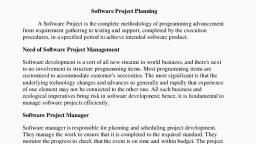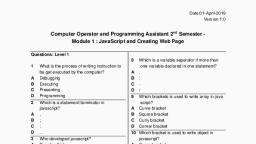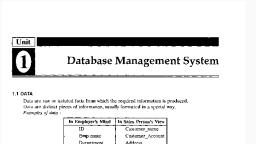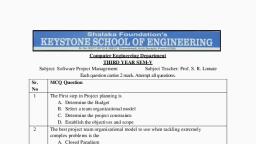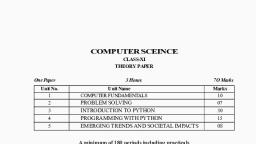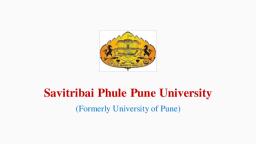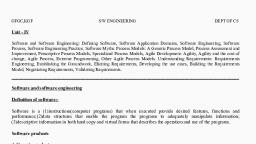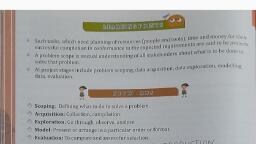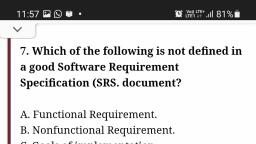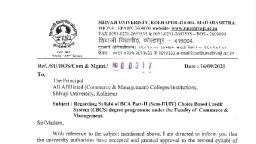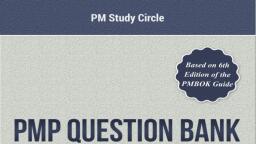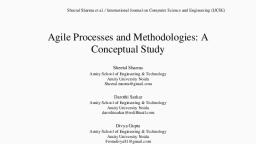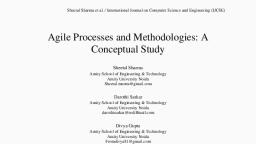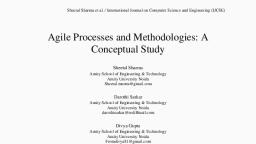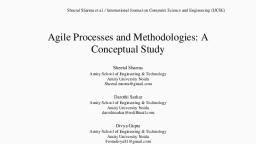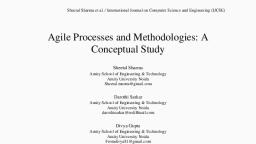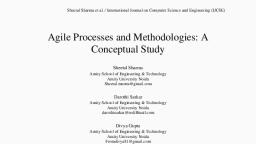Page 1 :
Timestamp, , Name of student, , Which is not constraint of project, Examples, management, of stakeholders?How many primitive data types in java?, , 9/12/2020 20:14:30 pindresh152@gmail.com, , Email Address, , Score, , Indresh, , shedule, , all of the above, , 6, , 9/12/2020 20:29:47 malik.vidushi27@gmail.com, , Vidushi malik, , task, , all of the above, , 7, , 9/12/2020 22:38:16 minakshiumate29@gmail.com, , Minakshi, , Quality, , government, , 7
Page 2 :
University of Mumbai (UoM), Subject: Software Project Management [USIT501], Programme: B.Sc. (Information Technology), Class and Semester: Third Year and V, Chapter Number: Introduction to SPM, Sr No, , Question, , Option 1, , Which of the following is not project management a) Keeping overall costs, 1 goal?, within budget., Acooording Fred Brooks’ view the software, product have certain charctercstics, a)People, Quality, Process, and Productivity, 2, ____ is a temporary endeavor undertaking to, 3 create a unique product, service, or result., Project, A ___ is a central document that defines the, 4 fundamental information abou a project., Product Charter, 5 ___ are people who have interest in the project., , 9 Who suggests W5HH Principle?, 10 The main three project atributes are, The plase with which proejct management life, 11 cycle starts before software devlopment life cycle, 12 RFQ in project bidding stands for, When Scope change is initiated from team, 13 members, _____ is uncontrolled changes in scope. This can, be because of interference from the customer or a, misunderstanding by the project management, 14 team and is also known as requirements creep, Which developement model is a combination of, classic life cycle model and iterative, 45, developement model?, 46, Which of the following is not a Scrum artefact?, Which of the following is not principle of Agile, 47, methods?, 48, , Option 3, , b)Performance, Robustness,, Maintainability and, Reusability, , c) Complexity, Conformity,, Changeability and Invisibility, , Taks, , Option 4, , c) Maintaining a happy and well- d) Avoiding costumer, functioning development team. complaints., , Correct Option, , d, , d)Accuracy, Testability,, Visibility and, Changeability.", , c, , Job, , Plan, , A, , Project Charter, , Project Chart, , Product Report, , B, , Directors, , Stakeholders, , Specific, Measurable,, Suitable, Measurable,, Achievable, Relevant, Timely Actionable, Reviewed, Timely, , Citizens, C, Standardised, Measurable,, Actionable, Resourced,, Timely, B, , Execution, , Closure, , Initiation, , D, , Release Management, , Scope Management, , Configuration Management, , Quality Management, , C, , Boehm, a) Cost, , Stallman, b) Duration, , Henry, c) Effort, , Bob, d) All of above, , A, d, , a) Planning, a) Request for Quotation, , b) Execution, c) Request for Question, , c) Initiation, c) Responce for Quotaion, , d) Closure, d) Request for Question, , c, a, , a) Scope Creep, , b) Gold Plating, , c) Requirment management, , d) None, , b, , a) Scope In, , b) Requirment In, , c) Scope creep, , Requirment Creep, , c, , a)Spiral model, a)Product Backlog, , b)Agile Developement model, b)Sprint Backlog, , c)Prototyping Model, c)Sprint Breakdown Chart, , d) Scrum, d)Project Charter, , a, d, , a)Incremental delivery, , b)Maintain simplicity, , c)No customer involvement, , d)Embrace change, , c), , Managers, Spectacular, Measurable,, Actionable, Resourced,, Timely, , 6 What does SMART stand for?, The software proejct management life cycle starts, 7 with ___ phase., Planning, , 8 Change management is also known as ___, , Option 2, b) Delivering the software to, the customer at the agreed, time.
Page 3 :
University of Mumbai (UoM), Subject: Software Project Management [USIT501], Programme: B.Sc. (Information Technology), Class and Semester: Third Year and V, Chapter Number: 2, , Sr No, Question, , Option 1, , Option 2, , Option 3, , Option 4, , Correct Option
Page 4 :
University of Mumbai (UoM), Subject: Software Project Management [USIT501], Programme: B.Sc. (Information Technology), Class and Semester: Third Year and V, Chapter Number: 3, Sr No, 1, 2, 3, 4, 5, 6, 7, 8, 9, 10, 11, 12, 13, 14, 15, 16, 17, 18, 19, 20, , Question, Option 1, Option 2, Option 3, Option 4, Correct Option, Project Schedule, for eachAll, task, of the above, 4, The project plan inncludes the following, Project Charter Time and cost estimates, A _________ report helps in determining the validityQuality, or scope of the entire, Feasibility, project, Study, or Completion, a part of the project., Cost Estimate, 2, The feasibility study comprises of _____, Executive summary, define the bussiness, Purpose, probleem, of the feasibility, All of thestudy, above, 4, The project scope statement is not based on :, Project Requirement, Feasibility StudyProject Cost, Objectives, 3, The project scope statement is the output of the effortsProject, of : ManagerProject Sponsor Key StakeHolders, All of the above, 4, Which of the following is not the componant of the project, Projectscope, Charter, document?, Scope Description, Project Acceptance, Project, Criteeria, Constraints, 1, As per the project management body of knowledge, the, Project, knowledge, scope initiation, area, Project, of project, process, scopescope, definition, Project, management, cost, process, benefit, Project, does, process, not, scope, comprise, verification, of which, process, one of the following?, 3, ________ Process checks the scope for accuracy and The, completeness, scope verification, the scope definition, the scope changethe, control, scope initiation, 1, The project _________ defines all the project work, activities, Scope Verification, and deliverables, Scope Planning, that enable, Scopeit change, to accomplish, control, Scopethe, Initiation, projects MOV., 2, The Project Scope _____________ protects the scopeChange, boundaries, Control, from, Verification, expanding unnecessary, Planning due demands, Initiation, of additional feeeatures and functionss to the project scope., 1, The Project Scope ______ process, the project sponsor, Change, gives the, Control, project, Verification, managers thePlanning, authority and resources, Initiationto define the project scope., 4, The Project scope ________ process identify the project, Change, deliverables, Control Verification, and the product Planning, deliverables. Initiation, 3, __________ scope defines the work that needs to be accomplished, Product Oriented, to Project, deliver OrientedCost, an information, Oriented, system with, NNone, specified, of these, feeatures sand functions., 2, __________ scope definition focuses on the feeaturesProduct, and fuctions, Oriented, that, Project, characterize, OrientedCost, an information, Oriented system, NNone, that, ofisthese, to be developed, 1, Which of the following is not the input for project scope, Deliverables, verification. MOV, Cost Oriented Quality Standards, 3, Which of the following is the outputs for project scope, Accepted, verification?, Deliverables, Change RequestRecommend corrective, All of the, action, above, 4, What of the following , Scope conntrol is supposed toScope, address?, Grope Scope Creep Scope Leap, All of the above, 4, __________ describes the Project team inability to define, Scopethe, Grope, project Scope, scope. Creep Scope Leap, None of the above, 1, _________ is also called as requirement creep , fuction, Scope, creepGrope, or feature, Scope, creep., Creep Scope Leap, None of the above, 2, __________ is a complete change in the scope, objective, Scope, andGrope, focus ofScope, the project., Creep Scope Leap, None of the above, 3
Page 5 :
University of Mumbai (UoM), Subject: Software Project Management [USIT501], Programme: B.Sc. (Information Technology), Class and Semester: Third Year and V, Chapter Number: 4. Selection Of An Appropriate Project Approach, Sr No, , Question, , Option 1, , Option 2, , Option 3, , Option 4, , SDLC stands for?, , A.Software Design Life Cycle, , B. Software Development Life, Cycle, , C. System, design Life, Cycle, , D. System, Development, Life Cycle, , Correct Option, , newly updated, A, , B, , C, , D, , E, , F, , G, , H, , University of Mumbai (UoM), Subject: Software Project Management [USIT501], Programme: B.Sc. (Information Technology), Class and Semester: Third Year and V, Chapter Number: 4. Selection Of An Appropriate Project Approach, , 1, 2, 3, 4, 5, 6, , Question, , Option 1, , 8, , 1, , RAD stands For, , A.Rapid Application Development, , 9, , 2, , SDLC stands for?, , 10, , 3, , Waterfall Model also called as, , 7, , Sr No, , Option 2, , Option 3, , Option 4, , A.Software Design Life Cycle, , B. Repeated, Application, Developement, B. Software, Development, Life Cycle, , C. Ready, Application, Development, C. System, design Life, Cycle, , D. Relative, Application, Development, D. System, Development, Life Cycle, , Correct Option, , A. Linear Sequencial Model, , B. Classic Life, Cycle Model, , C. One Shot, C. Includes, project risks, evaluation, during each, stage, , D. All of These, , 4, , D. All of These, , 3, , D. All of These, D.Planning ,, Design ,Coding,, Testing, , 4, , 1, , 2, , 14, , 7, , Choose the correct option from given below:, , A.Prototyping Model facilitates, reusability of components, , B.Is more, chaotic than, Incremental, Model, B.Can Easily, accommodate, product, requirement, change, B.Planning ,, Analysis,, Design ,Coding, B.RAD Model, Model, facilitates, reusability of, components, , 15, , 8, , Main objective of Kanban, , A.Visualise the workflow, , B.Define, Requirement, , C.Show Daily, Scrum, , D.Sprint, Backlog, , 1, , 16, , 9, , Who is responsible for Scrum Model, , A.Developer, , B.Tester, , C.Prodect, Owner, , D.Archtecture, , 3, , 17, , 10, , How much week requires to develop the, sprint, , A.1 to 3 Weeks, , 18, , 11, , Important artefact for scrum methodology, , A.Product Backlog, , B.2 to 4 Weeks C.5 to 6 Weeks D.2 to 5 Weeks, C.Sprint, B.Sprint, Burndown, Backlog, Chart, D.All of these, C.Requirement,, B.Planning ,, Enggineering, D.Analysis ,, Analysis,, Deployment ,, Design ,Coding,, Design ,Coding Maintenence, Testing, , 11, , 12, , 13, , 19, , 4, , Th Spiral Model of software development, , A. Ends with the delivery of the, software product, , 5, , Evolutionary Software Process Model, , A.Are Itrative in nature, , 6, , What are the four framework activities found in, Extreme Programming (XP) process model, , A.Analysis,Design ,Coding,Testing, , 12, , Life Cycle stages of ATERN Model, , A.Feasibility,Exploration,, Engineering,Deployment, , 13, , If the Project deadline is tight which model is, suitable, , A.Prototyping Model, , 21, , 14, , What is Pair Programming?, , A.It is a programming process,, wherein a programmer writes the, program twice just in case., , B.Evolutionaty, Model, B.A, development, method, where, two developers, work on the, same, workstation., , 22, , 15, , Which of the following is NOT a practice of, Extreme Programming?, , A.Test-Driven Development, , B.Small, Releases, , 17, , Lean Developement model has main focus A. To provide visibility to the, on, workflow, Which development model would be, appropriate for developement of simple and, well-understood application?, A.Spiral Developement Model, , 20, , 23, , 24, , 25, , 18, 19, , C.Do not, generally, Throw Away, Approach, C.Planning ,, Analysis,, Design ,Testing, , 3, , C.Waterfall, Model, , C.It is an, algorithm that, finds pair, numbers in a set, of integers., C.Shared Code, and, Responsibility, , C.Kanban, C.Dynamic, Systems, Developement, Method, C.Horizontal, Prototype, , 2, , 4, , 1, , D.Spiral Model, , 2, , D.It is a way of, rectifying errors, in programs by, looking for, pairs of errors., , 2, , D.Empower, Customers, D.Decreasing, programming, efforts,, budgeting and, defect rates,, B.To deliver, delay in, work parts, staffing and, after, C.It delivers a excessive, completion of work product documentation, a sprint, in one shot, ., , B.Waterfall, Model, B.Discrete, Software, A.Database System Developement Developement, DSDM is an abbreviation of, Model, Model, B.Vertical, A.Evolutionary Prototype, Prototype, Which prototype tests out some ideas and then discarded?, , 4, , C.Sprial Model, facilitates, reusability of, components, D.Both A and B, , 3, , 4, , D.Atern, Development, Model., , 2, , D.Direct, Software, Design, Method, , 3, , D.Throw away, prototype, , 4, , D.
Page 6 :
Which of the following is not a, disadvantage of off-the-shelf(OTS), software?, , 20, 1, , A.Customer does not own the, code and cannot change it., , B.Danger of, over-reliance, on a single, supplier., , C.Customer, may need to, change the, way they work, in order to fit, in with OTS, application., , D.Cheaper as, supplier can, spread, developement, costs over a, large number, of customers., , 4, 2, , 1, 3, 4, 2, , 1
Page 7 :
University of Mumbai (UoM), Subject: Software Project Management [USIT501], Programme: B.Sc. (Information Technology), Class and Semester: Third Year and V, Chapter Number: 5 Software Effort Estimation, Sr No, 1, 2, , 3, , 4, , 5, 6, , Question, Function count method was developed by, What is related to the overall functionality of the, delivered software?, which one of the following is developed using, historical cost information that relates some, software metric to the project cost, Which technique is applicable when other projects, in the same analogy application domain have been, completed?, Which may be estimated either in terms of KLOC, (Kilo Line of Code) or by calculating number of, function points in the software?, Which of the following states that work expands to, fill the time available., , Option 1, B.Boehm, Functionrelated metrics, , 1, , Algorithmic, Expert, cost modelling judgement, , Estimation by Parkinson’s, analogy, Law, , 3, , Time, estimation, , 9, , 10, , COCOMO stands for, , 11, , 12, , COCOMO-II estimation model is based on, Which of the following is not an information, domain required for determining function point in, FPA ?, , 13, , Which one is not a size measure for software, product?, , LOC, , 14, 15, , COCOMO was developed initially by, Estimation of size for a project is dependent on, , B.Beizer, Cost, , FP-Based, Estimation, , Constructive, cost model, Algorithm, approach, Number of, user Input, , Early design, estimation, model, , Effort, estimation, , Cost, estimation, Parkinson’s, Pricing to win Law, A postarchitecture, model, , Software size, estimation, Expert, judgement, , An early, A reuse model design model, , A postarchitecture, model, , An early, A reuse model design model, Both FPBased, Process-Based, Estimation and, Estimation, COCOMO, COCOMO, Constructive Complete cost, Comprehensiv cost estimation estimation, e cost model model, model, Complex, Bottom up, Top down, approach, approach, approach, Number of, Number of, Number of, external, user Inquiries errors, Interfaces, Halstead’s, program, Function, Cyclomatic, length, Count, Complexity, Gregg, B.W.Bohem Rajiv Gupta, Rothermal, Time, Schedule, FP, Application, Comprehensiv Post, Composition e cost, architecture, estimation, estimation, estimation, model, model, model, , 18, , Which one is not a stage of COCOMO-II?, Function point analysis (FPA) method decomposes, the system into functional units. The total numbers, of functional units are, 5, 4, In Intermediate COCOMO the mode that represents, complex products is referred to as, Semidetached Embedded, , 19, , As a software manager, when you will decide the, number of people required for a software project?, , Before the, scope is, determined., , What is the meaning of Software Scope?, , It describes, the Off-theshelf, component., , 20, , Correct Option, 3, , 1, , Which of the following uses empirically derived, formulas to predict effort as a function of LOC or, FP?, , 17, , Option 4, M.halstead, LOC-related, metrics, , Estimation by Parkinson’s, analogy, Law, , 8, , 16, , Option 3, Alan Albrecht, Size-related, metrics, , Algorithmic, Expert, cost modelling judgement, , CASE tools, An, Which model is used during early stages of the, applicationsystem design after the requirements have been, composition, established?, model, Which model is used to compute the effort required An, to integrate reusable components or program code applicationthat is automatically generated by design or, composition, program translation tools?, model, , 7, , Option 2, B.Beizer, Productrelated metrics, , Before the, Planning, phase., It describes, the functions, and features, that are to be, delivered to, end users., , 4, 3, , 4, , 3, , 4, , 1, 1, , 3, , 4, 2, 4, , 3, , 3, , 2, , 1, , Organic, Before an, estimate of the, development, effort is made., , Multiplicative, After an, estimate of the, development, effort is made., , 2, , It describes, the software, risk., , It describes, the project, risk., , 4, , 2
Page 8 :
21, , 22, , 23, , 24, , 25, , Determination, What is the first activity in Software Project, of software, Planning?, scope, The model which estimates the total effort in, terms of person, months of the technical project, staff is, Spiral Model, Information, LOC Based techniques requires problem, Domain, decomposition based on, Values, Information, FP Based techniques requires problem, Domain, decomposition based on, Values, Information, Process Based techniques requires problem, Domain, decomposition based on, Values, , Determination Find out the, of budget, team size, , Find out the, program size, , 1, , Waterfall, model, , Win-win spiral Cocomo, model, Model, , 4, , Project, Schedule, , Software, functions, , Process, activities, , 3, , Project, Schedule, , Software, functions, , Process, activities, , 1, , Project, Schedule, , Project cost, , Process, activities, , 4
Page 9 :
University of Mumbai (UoM), Subject: Software Project Management [USIT501], Programme: B.Sc. (Information Technology), Class and Semester: Third Year and V, CHAPTER 6- activity planning, Sr No, , Question, , Option 4, , Correct Option, , Which of the following is NOT the objective of, 1 Activity Planning, , Option 2, Option 3, Cutting down, on, Resource, Requirements Allocation, , Detailed, Costing, , B, , 2, , Revised at, regular, can be unclear intervals, , Monitoring, does not assist, Planning, , C, , Fund, allocation, , Resource, Allocation, , Activity Risk, Analysis, , B, , Product Based, Approach, Project, Examination, Review, Technique, , Activity Based, Approach, Program, Evaluation, Rejection, Technique, , Hybrid, Approach, Program, Evaluation, Review, Technique, , Crucial Path, Method, , Critical Path, Method, , 3, , 4, , 5, , 6, 7, , Option 1, , Feasibility, Assessment, Should be, Finalised at, the beginning, What is TRUE for activity Plan, only, Constructing, For schedule creation, which of the following stage ideal activity, is NOT required, plan, Planning, Which of the following is NOT an approach to, Based, identify Activity, Approach, Planning, Examination, Resourcing, PERT stands for, Technique, Critical, Planning, CPM stands for, Method, Which of the following is NOT related to Network, Planning Methods, GANTT Chart, , 8 GANTT Chart is NOT used for, Which of the following is most useful to, decompose big projects into smaller modules or, 9 tasks, , 10 In PERT Chart Dummy activity is required if:, , 11 Which of the following is TRUE for Critical Path, , 12 Lagged Activities are used when, 13 Hammock Activities have, , 14 Critical Path is that Path where:, , 15 To shorten Project Duration, , Crucial Path, Management, Precedence, CPM, PERT, Network, Resource, Deciding, Scheduling, Staffing, Allocation, Priorities, Work, Breakdown, PERT Chart, GANTT Chart Task Network Structure, Two or more, Two or more activities have Two or more Two or more, activities have identical, activities have activities have, same ending starting and, different, same starting, events, ending events ending events events, It is a path, having, It is the path, maximum, It is shortest, It is the, with largest, number of, Path in terms longest Path in amount of, Tasks, of Time, terms of Time float, Two activities, can be started, in parallel, provided there, is a delay, between 2, activities, Maximum, Duration, Delay in any, one of the, activities on, this path can, delay the, project, , when activities, can be, When, completed, activities are, later, not required, Optimum, Zero Duration Duration, , there is, maximum, float, , Duration of, activities on, Non Critical, Path should be Its not, reduced, Possible, , Which of the following is NOT TRUE for activity Every Node, It has one, 16 on arrow Networks, has a Duration Ending Node, , when activities, are very, important, Negative, Duration, , attention is not Float has to be, required, greater than 5, More, resources, should be, allotted to, activities on, non critical, Path, Network May, contain, Dangles, , A, , D, , C, A, D, , D, , B, , C, , A, B, , A, , Duration of, activities on, Critical Path, should be, reduced, , D, , It has one, starting Node, , C
Page 10 :
For labelling activity, information on activity-on17 arrow network does Not include, , PROF. NIDHI SINGH, Lala lajpatrai College of Commerce and Economics, , Event ID, , Event Name, , Earliest Date, , Latest Date, , B
Page 11 :
University of Mumbai (UoM), Subject: Software Project Management [USIT501], Programme: B.Sc. (Information Technology), Class and Semester: Third Year and V, Chapter Number: 7, Sr No, , Question, , Option 1, , Option 2, , Option 3, , Option 4, , 1, , which one of the following is the correct sequence, of the activities recommended by a typical, proactive risk management framwork, , 2, , two main approchase to identification of risk are, the use of, , Risk Cotrol,, Risk, Identification &, risk, Assesment, checklist &, brain storming, , Risk, Assesment,, Risk, Identification &, Risk Control, strategies &, brain storming, , Risk, Identification,, Risk, Assesment &, Risk Control, checklist &, staffing, , Risk, Identification,, Risk Control &, Risk, Assesment, staffing &, scheduling, , Correct Option, , 3, , Risk Exposure =, , (Potential) x, (occurance), , (Potential, Damage) x (, Probability, Occurance), , Risk Recovery Cost of, x Risk, Damage x, Damage, cost of, recovery, , 4, , What is mean by COTS, , cost of the, software, , What is mean by MCS, , Monte carlo, stimulation, , communicatio, n of the, system, Monte Carlo, Shelf, , 2, , 5, , commercial off correct, the shelf, outcome to, system, Monte carlo, Monte Carlo, Series, System, , 6, , CCPM Stands for, , Critical, change, Project, Management, , Critical, Change, Product, Management, , Complect, change, production, management, , Critical Chain, Product, Management, , 1, , 7, , Project buffers are divided into three zones, , Green,Amber, Green,Yellow, Green,Pink &, & Red, & Red, Yellow, , Red, Green &, Blue, , 1, , 8, , PERT Model requires _____ Time Estimates for, each activity, , Two, , One, , Three, , Four, , 3, , 9, , CPM Models Requires____ Times Estimate for, each activity, , One, , Two, , Three, , Zero, , 1, , 10, , Optimestic times means, , Shortest, possible time, , Computational Most Likely, Time, Times, , 1, , 11, , Pessimistic times mean, , Shortest, possible time, , Computational Most Likely, Time, Times, , 2, , 12, , Grantt Chart Developed by, , Messi Grantt, in 1917, , Longest, Possible Time, required to, perform, activity, Longest, Possible Time, required to, perform, activity, Henry Grantt, in 1917, , Tom Grantt in Williams, 1917, Grantt in 1917, , 2, , Risk, 3, Assesment,, Risk Control &, Risk, Identification, 1, 2, , 1
Page 12 :
University of Mumbai (UoM), Subject: Software Project Management [USIT501], Programme: B.Sc. (Information Technology), Class and Semester: Third Year and V, Chapter Number: ____________, Sr No, , Question, 1 A resource is any item or person required for the ___________, 2 Which of the following is not categories of resources?, Ordered list priority of Resource Allocation was conceptualised, 3, by?, What are the factors need to be taken into account while, 4 allocating individuals to tasks, __________ will benefit the organisation if positive steps are, taken to allocate junior staff to appropriate non critical, 5 activities., 6 Which are the categories of cost?, Prof Vinay Vilas Shahapurkar, SM Shetty College, , Option 1, Option 2, Option 3, Option 4, Completion of Project Estimation of Project Execution of Project Termination of Project, Labour, Equipment, Money, Reviews, , Correct Option, Option 3, Option 4, , Boehm, , Burman, , Henry, , John, , Option 2, , Availability, , Criticality, , Training, , All of the above, , Option 4, , Recruitment, Usage, , Training, Staff Costs, , Incentives, Overheads, , Team Building, All of the above, , Option 2, Option 4
Page 13 :
University of Mumbai (UoM), Subject: Software Project Management [USIT501], Programme: B.Sc. (Information Technology), Class and Semester: Third Year and V, Chapter Number: 9 Monitoring and control, Sr No, 1, 2, 3, 4, 5, 6, 7, 8, 9, 10, 11, 12, 13, 14, 15, , Question, Option 1, Option 2, Option 3, Option 4, Correct Option, End of stage review meeting is asn example of, oral formal regular meeting, oral formal ad hoc meeting, oral informal ad hoc meeting, written formal ad hoc meeting, 2, not on target and recoverable only withon, difficulty, target and recoverable, 1, The scale amber in RAG reporting denotes, on target, not on target but recoverable, Who among the following schedules the review meeting, recorder, moderator, reviewer, author, 2, The review process works best when the number of memebers is between, 10-15, 1-3, 5-7 more than 15, 3, The phase where the work product of the author is distributed to the review team members, reviewsimeeting, called as, rework, preparation, moderation, 3, Which of the following is NOT a report in which the review data is captured?, Review log, Review charter, review prepration log, review summary report, 2, Which technique is best suited for long duration projects to assign earned value, the 0/100 technique, 75/25 technique, milestone technique, 50/50 technique, 3, schedule, cost, earned value, 2, D. System Development Life Cycle, time, control of changes and documenttion is the resposibility of the, project manager, reviewer, developer, 1, configuration librarian, the following is required to run the software on different operating systems, baseline, version, revision, variant, 4, EV/PV is the formula for, CPI, SCM, SPI, 4, BAC, In this log only those defects that are agreed upon by the uthor is logged, review summary report, Review log, Review charter log, review prepration log, 2, Preparation phase in review process is followed by, rework, followup, review meeting, planning, 3, Weekly or monthly progress meetings may be associated with, reports that are oral,with formal writen, reportsminutes, that are largely oral,likely towith, receive, forms, and generate written reports providing early warnings, 1, daya to day responsibiity of the project progress is in the hands of the, team leader, project manager, project steering committee, developer, 2
Page 14 :
University of Mumbai (UoM), Subject: Software Project Management [USIT501], Programme: B.Sc. (Information Technology), Class and Semester: Third Year and V, Chapter Number: ____________, Sr No, 1, 2, 3, 4, 5, 6, 7, 8, 9, 10, 11, 12, 13, 14, 15, 16, 17, 18, , Question, Option 1, Option 2, Option 3, Option 4, Correct Option, In FP, adjustment factor is in the first of Select one:, 16 – 20, 0–5, 6 – 10, 11 – 15, 2, COTS stand for, Commercial of the shelf, Customized of the shelf, Customer of the shelf, Consumer of the shelf, 2, Tenders are requested from suppliers in, memoranda of agreement, meetings of agreement, suppliers of agreement, sender of agreement, 1, Who can be owner of software, customer, supplier, stakeholder, all the above, 4, Bespoke systems are specially created for, customer, supplier, stakeholder, vendors, 1, Methods used for evaluation plan doesnot include, reading proposals, interview, site visit, requirements, 4, In open tendering, all tenders must be evaluated in same, all tenders, way must be evaluated in different, one tenders, way, must be evaluated, more than tender must be evaluated, 1, Stages in contract placement are, collection, requirements analaysis, implementation, designing, 2, contract should always reflectrequirement and expectation of, client, supplier, client and supplier, consumer, 2, Contracr checklist includes, commitment, environment, standard to be mer, all the above, 4, Tenders are judged on, scope, price, quality, time, 1, Acceptance criteria will be included in, supplier management, contract management, total management, customer management, 2, fee could be paid forfor technical proposals by, supplier, customer, stakeholder, vendors, 2, Bidder can make response to, client, supplier, invitation to tenders, stakeholder, 3, Requirement documents include, system requirements, deadlines, future strategy and plan, all the above, 4, By which means is a contractor able to control costs overruns due to changing requirements project data review, change order, change control, contract negotiations, 3, The __ specification describes ,defines or specifies the goods/services to be supplied., performance, functional, technical, Bid, 4, The selection of the type of contract is important because of the cost risk involved. In most cases,, Fixed, the buyer, price (owner) will attempt to, Cost-plus, transfer the risk to the seller (project, Time and, sponsor)., materials, The buyer, therefore,, Definitive, will always attempt to award a(n) __________ contract to, 1 the seller.
Page 15 :
University of Mumbai (UoM), Subject: Software Project Management [USIT501], Programme: B.Sc. (Information Technology), Class and Semester: Third Year and V, Chapter Number: 12 Working in Teams, Sr No, , Question, , Option 1, , Option 2, , Option 3, , Option 4, , Correct Option, , 1, 2, 3, 4, 5, 6, 7, 8, , 9, 10, 11, 12, 13, 14, 15, 16, , D, , 17, , D, , 18, , D, , 19, , A, , 20, 21, 22, , D
Page 16 :
University of Mumbai (UoM), Subject: Software Project Management [USIT501], Programme: B.Sc. (Information Technology), Class and Semester: Third Year and V, Chapter Number:13 (Software Quality), Sr No, 1, 2, 3, 4, 5, 6, 7, , 8, , 9, 10, 11, 12, 13, 14, 15, , Question, The ease with which it is possible to locate and fix bugs in the, software product is termed as, Which software quality model is based on wider range of software, attributes and with greater focus on software maintainability, Software quality which relates to the ability of the software to be transffered, to a different environment, ____________ refers to the degree to which the software adheres to the, application -related standards or legal requirements., __________ refers to the factor that give upwards compatibility between, old software components and the new one, which of of the following is not based on three level characteristics in Boehm's, model., ___________ aims at reengineering the way business is carried out in an, organization, At which maturity level in CMM ,organization usually practice some, basic project management practices such as planning and tracking, cost and budget., Name the process That helps in developing personal skills and methods by, estimating ,planning and tracking performance against plans ,and provides a, defined process which can be tuned by individuals, ___________ model was introduced as an extension to the waterfall process, model, __________ is the process of determining whether the output of one phase, of software development conforms to that of its previous phase, The objective of _________ testing is to check whether the modules have any, errors pertaining to interfacing with each other., Name the testing which checks whether the unmodified functionalities still, continue to work correctly, Name the model which allows for negative reliability growth to reflect the fact, that when a repair is carried out,it may introduce additional errors., __________ is the time between two successive failures,averaged over a, large number of failures., , Option 1, , Option 2, , Option 3, , Correctness, , Maintainability, , Potability, , McCall's Model, , Boehm's Model, , Portability, , Option 4, , Correct Option, , Reusability, Gravin's Quality, Dromey's Model dimensions, , 2, , Usability, , Productivity, , 1, , Maturity, , Functionality, Functionality, Complaince, , Learnability, , Interoperability, , 2, , Coexistance, , Adaptability, , Installability, , Replaceability, , 4, , As-in Utility, , Maintainability, , Testability, , Portability, , 3, , BPR, , CMM, , PSP, , CMMI, , 1, , Level 1, , Level 2, , Level 3, , Level 4, , 2, , Personal Software, process, Six Sigma, , Test automation, , Reliabilty Metrics, , 1, , RAD model, , Incremental model, , Spiral Model, , V-process Model, , 4, , Validation, , Verification, , Testng, , Test Care, , 2, , Unit Testing, , Integration Testing, , System Testing, , 2, , Resolution testing Regression Testing, Jelinski and, Goel-Okutomo, Moranda Model, Model, , Load Testing, Littlewood and, Verall's Model, , Maintenance Testing, User Acceptance, Testing, Software Developemt, Model, , MTTF, , MTTR, , MTBF, , 1, , ROCOF, , 2, , 2, 3
Page 17 :
University of Mumbai (UoM), Subject: Software Project Management [USIT501], Programme: B.Sc. (Information Technology), Class and Semester: Third Year and VI, Chapter Number: 14 - Project Closeout, Sr No, , Question, , 1 There are many reasons to close a project except, , Option 1, It has been, accepted, positively by, customers, , Premature closing of project can be done for the given, 2 reasons except, , Lack of, resources, , Option 2, All, requirements, are completely, incorporated, Changed, business need, of the, customer, , Option 3, , Option 4, , There is, shortage of, funds, , The tester, does not like, the project, , 4, , A lot of, money is, allocated, , Changes to, regulatory, policy, , 3, , Underestimati, on to the, decay of, knowledge, Lots of, Indecision, which, Reasons projects are not closed properly are as follows, Emotional, interest shown regarding, diminishes, 3 except, factors, by everyone, project closure with time, Locking up, valuable, Stress on, human and, Time and cost, project, other, 4 Improper closure of projects leads to the following except overrun, Happiness, personnel, resources, Removal by, Diversion of, customers, attention to, Client loses, Emotional problems associated with project closure are due before project reassigning to India lost a, interest in the, 5 to the following reasons except, ends, other projects cricket match project, , In case of an intellectual project termination the following, 6 tasks have to be performed, , 7, , The, outstanding, commitments, Everyone will The terms of from, divide the, contract needs subcontractors, money and, to be, needs to be, relax, renegotiated, renegotiated, Validate, overall, Capture, ensure all, progress to, knowledge, documentation, date against, and document is accepted, the budget and it for future, and signed by, schedule, usage, the sponsor, , Correct Option, , 2, , 2, , 3, , The list of, deliverables, have to be, renegotiated, , 1, , Establish that, project, benefits have, been identified, , 2, , To suggest, To determine, means to fineTo review the which, to fix, tune various, qualitative and practices, accountability techniques, quantitative, worked well, for, used for, Which one of the following is not an objective of the, data about the and which did performance project, 8 postimplementation review?, project, not, shortfalls, estimations, To determine, which, To determine, techniques, which, worked well, techniques did To fix, To fine-tune, so that so that not work well, accountability, In the process of postimplementation project review, which the errormore effort, so that so that for the errors, one of the following is not a reason for collecting the data detection, can be, less effort can comitted at, concerning the errors detected at various stages of the, techniques, allocated to, be allocated to each stage of, 9 development, used, both, them, development, , 1, , 4


